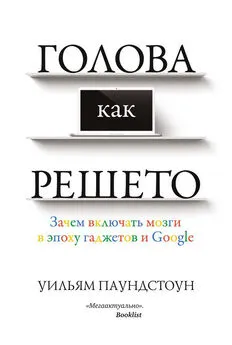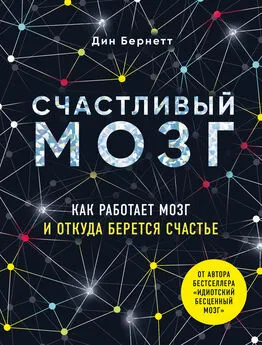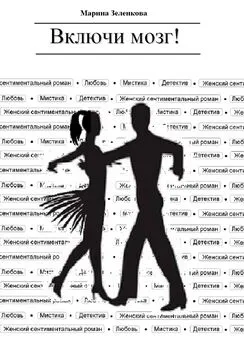Кэролайн Лиф - Включите свой мозг
- Название:Включите свой мозг
- Автор:
- Жанр:
- Издательство:неизвестно
- Год:неизвестен
- ISBN:нет данных
- Рейтинг:
- Избранное:Добавить в избранное
-
Отзывы:
-
Ваша оценка:
Кэролайн Лиф - Включите свой мозг краткое содержание
Включите свой мозг - читать онлайн бесплатно полную версию (весь текст целиком)
Интервал:
Закладка:
[60] Marcus E. Raichle, “The Brain’s Dark Energy,” Scientific American, March 20, 2012, 44–49, www.hboorcca.com/pdf/brain/The%20Brain’s%20Dark%20Energy%20Scientific%20American%20March%202010.pdf; Raichle et al., “A Default Mode of Brain Function,” 1083–90.
[61] Yvette I. Sheline et al., “The Default Mode Network and Self-Referential Processes in Depression,” Proceedings of the National Academy of Sciences USA 106, no. 6 (January 26, 2009): 1942–47; Washington University School of Medicine research cited in “Alzheimer’s Breaks Brain Networks’ Coordination,” Science Daily, September 17, 2012, www.sciencedaily.com/releases/2012/09/120918090812.htm.
[62] Raichle, “The Brain’s Dark Energy”; Raichle et al., “A Default Mode of Brain Function.”
[63] Konnikova, “The Power of Concentration.”
[64] Brier et al., “Loss of Intranetwork and Internetwork Resting State Functional Connections with Alzheimer’s Disease Progression.”
[65] J. Paul Hamilton et al., “Default Mode and Task Positive Network Activity in Major Depressive Disorder: Implications for Adaptive and Maladaptive Rumination,” Biological Psychiatry 70, no. 4 (2011): 327–33.
[66] Caroline M. Leaf, “Mind Mapping: A Therapeutic Technique for Closed Head Injury,” unpublished master’s dissertation (University of Pretoria, Pretoria, South Africa), 1990.
[67] “Activity in Brain Networks Related to Features of Depression,” Science Daily, April 3, 2012, www.sciencedaily.com/releases/2012/04/120403111954.htm#.T4HbzAjE61c.mailto.
[68] Xueling Zhu et al., “Evidence of a Dissociation Pattern in Resting-State Default Mode Network Connectivity in First-Episode, Treatment-Naive Major Depression Patients,” Biological Psychiatry 71, no. 7 (2012): 611.
[69] Norman A. S. Farb et al., “Mood-Linked Responses in Medial Prefrontal Cortex Predict Relapse in Patients with Recurrent Unipolar Depression,” Biological Psychiatry 70, no. 4 (August 15, 2011): 366–72.
[70] Leaf, “The Mind Mapping Approach”; Hamilton et al., “Default Mode and Task Positive Network Activity in Major Depressive Disorder.”
[71] Sophie Green et al., “Guilt-Selective Functional Disconnection of Anterior Temporal and Subgenual Cortices in Major Depressive Disorder,” Archives of General Psychiatry 69, no. 10 (2012): 1014–21, http://archpsyc.jamanetwork.com/article.aspx?articleID=1171078.
[72] Ibid.
[73] Schwartz and Begley, Mind and the Brain; Schwartz and Gladding, You Are Not Your Brain.
[74] Michael M. Merzenich et al., “Prophylactic Reduction and Remediation of Schizophrenic Impairments through Interactive Behavioral Training,” 2001, http://www.google.com/patents?hl=en&lr=&vid=USPAT6231344&id=3BQIAAAAEBAJ&oi=fnd&dq=Merzenich+schizophrenia+research&printsec=abstract#v=onepage&q=Merzenich%20schizophrenia%20research&f=false; Melissa Fisher et al., “Neuroplasticity-Based Cognitive Training in Schizophrenia: An Interim Report on the Effects 6 Months Later,” Schizophrenia Bulletin, March 5, 2009, http://schizophreniabulletin.oxfordjournals.org/content/36/4/869; “Thread: New Therapy Available Now for Cognitive problems in Schizophrenia,” http://www.schizophrenia.com:8080/jiveforums/thread.jspa?threadID=16719; Sophia Vinogradov, “What’s New in Schizophrenia Research,” November 28, 2007, http://www.thomastthomas.com/Schizophrenia%20Research,Vinogradov,112807.pdf.
[75] Sarah J. Hart et al., “Altered fronto-limbic activity in children and adolescents with familial high risk for schizophrenia,” Psychiatry Research 212, no. 1 (2013): 19; Sebastien Parnaudeau et al., “Inhibition of Mediodorsal Thalamus Disrupts Thalamofrontal Connectivity and Cognition,” Neuron 77, no. 6 (2013): 1151.
[76] “Women Abused as Children More Likely to Have Children With Autism,” Science Daily, March 20, 2013, http://www.sciencedaily.com/releases/2013/03/130320212818.htm#.UVCuOUPuaJE.email.
[77] Brian A. Primack et al., “Association Between Media Use in Adolescence and Depression in Young Adulthood,” Archives of General Psychiatry 66, no. 2 (2009): 181–88, http://archpsyc.jamanetwork.com/article.aspx?articleid=210196.
[78] Mark W. Becker, Reem Alzahabi, and Christopher J. Hopwood, “Media Multitasking Is Associated with Symptoms of Depression and Social Anxiety,” Cyberpsychology, Behavior, and Social Networking 16, no. 2 (2012): 132–35.
[79] “Are You a Facebook Addict?” Science Daily, May 7, 2012, www.sciencedaily. com/releases/2012/05/120507102054.htm.
[80] Report from the University of Edinburgh Business School, “More Facebook Friends Means More Stress, Says Report,” Science Daily, November 26, 2012, www. sciencedaily.com/releases/2012/11/121126131218.htm.
[81] Keith Wilcox and Andrew T. Stephen, “Are Close Friends the Enemy? Online Social Networks, Self-Esteem, and Self-Control,” Social Science Research Network, September 22, 2012, http://ssrn.com/abstract=2155864.
[82] David M. Levy et al., “The Effects of Mindfulness Meditation Training on Multitasking in a High-Stress Information Environment,” Proceedings of Graphics Interface, May 2012; University of Washington research referenced in “Mindful Multitasking: Meditation First Can Calm Stress, Aid Concentration,” Science Daily, June 13, 2012, www.sciencedaily.com/releases/2012/06/120614094118.htm.
[83] Leaf, “Mind Mapping: A Therapeutic Technique for Closed Head Injury”; Leaf, “The Mind Mapping Approach.”
[84] University of Washington study cited in Konnikova, “The Power of Concentration.”
[85] University of Washington and Emory University studies referenced in Konnikova, “The Power of Concentration”; Michael Merzenich, cited in Schwartz and Begley, Mind and the Brain; Gaelle Desbordes et al., “Effects of Mindful-Attention and Compassion Meditation Training on Amygdala Response to Emotional Stimuli in an Ordinary, Non-Meditative State,” Frontiers in Human Neuroscience, November 1, 2012, www.frontiersin.org/human_neuroscience/10.3389/fnhum.2012.00292/abstract.
[86] Michael Merzenich cited in Schwartz and Begley, Mind and the Brain. Desbordes et al., “Effects of Mindful-Attention and Compassion Meditation Training on Amygdala Response to Emotional Stimuli in an Ordinary, Non-Meditative State”; Massachusetts General Hospital, Boston University, “Meditation Appears to Produce Enduring Changes in Emotional Processing in the Brain,” Science Daily, www.science daily.com/releases/2012/11/121112150339.htm.
[87] Leaf, “Mind Mapping: A Therapeutic Technique for Closed Head Injury.”
[88] Eileen Luders et al., “The Unique Brain Anatomy of Meditation Practitioners: Alterations in Cortical Gyrification,” Frontiers in Human Neuroscience, February 29, 2012, www.frontiersin.org/Human_Neuroscience/10.3389/fnhum.2012.00034/abstract.
[89] Eileen Luders et al., “Enhanced Brain Connectivity in Long-Term Meditation Practitioners,” NeuroImage 4 (August 15, 2011): 1308–16.
[90] University of California, Los Angeles research cited in “Meditation May Increase Gray Matter,” Science Daily, May 13, 2009, www.sciencedaily.com/releases/2009/05/090512134655.htm.
[91] “Max Planck Quotes,” www.goodreads.com/author/quotes/107032.Max_Planck.
[92] Schwartz and Begley, Mind and the Brain; Schwartz and Gladding, You Are Not Your Brain; Jeffrey Schwartz, Henry Stapp, and Mario Beauregard, “Quantum Physics in Neuroscience and Psychology: A Neurophysical Model of Mind/Brain Interaction,” www.physics.lbl.gov/~stapp/PTB6.pdf.
[93] This intentional mental act and its unpredictability can be represented mathematically by an equation that is one of the key components of quantum theory. It is beyond the scope of this book to explore the equation more deeply, but if you are interested, you can begin exploring further by reading, “Quantum Physics in Neuroscience and Psychology: A Neurophysical Model of Mind/Brain Interaction,” by Jeffrey M. Schwartz, Henry P. Stapp, and Mario Beauregard, http://www.scribd.com/doc/94124369/Quantum-Physics-in-Neuroscience-by-Je»rey-M-Schwartz-Henry-P-Stapp-Mario-Beuregard.
[94] James Higgo, “A Lazy Layman’s Guide to Quantum Physics,” 1999, www.higgo.com/quantum/laymans.htm.
[95] Schwartz, Stapp, and Beauregard, “Quantum Physics in Neuroscience and Psychology.”
[96] Schwartz and Begley, Mind and the Brain; Schwartz and Gladding, You Are Not Your Brain; Schwartz, Stapp, and Beauregard, “Quantum Physics in Neuroscience and Psychology.”
[97] Caroline Leaf, “The Mind Mapping Approach: A Model and Framework for Geodesic Learning,” unpublished DPhil dissertation, University of Pretoria, South Africa, 1997; Caroline Leaf, “The Mind Mapping Approach: A Technique for Closed Head Injury,” unpublished master’s dissertation, University of Pretoria, South Africa, 1990.
[98] Carol Dweck, “Implicit Theories of Intelligence Predict Achievement Across Adolescent Transition: A Longitudinal Study and an Intervention,” Child Development 78 (2007): 246–63.
[99] McCraty, “Modulation of DNA Conformation by Heart-Focused Intention,” 4.
[100] Church, Genie in Your Genes.
[101] Giacomo Rizzolatti and L. Craighero,“The Mirror-Neuron System,” Annual Review of Neuroscience 27 (2004): 169–92.
[102] Caroline Leaf, Who Switched O! Your Brain? Solving the Mystery of He Said/She Said (Nashville: Thomas Nelson, 2011).
[103] Dean Radin, “Testing Nonlocal Observation as a Source of Intuitive Knowledge,” Explore 4, no. 1 (2008): 25.
[104] Thomas E. Oxman et al., “Lack of Social Participation or Religious Strength and Comfort as Risk Factors for Death after Cardiac Surgery in the Elderly,” Psychosomatic Medicine 57 (1995): 5.
[105] Linda H. Powell et al., “Religion and Spirituality: Linkages to Physical Health,” American Psychologist 58, no. 1 (2003): 36.
[106] Larry Dossey, Prayer Is Good Medicine (San Francisco: HarperOne, 1997).
[107] John A. Astin et al., “The Efficacy of ‘Distant Healing’: A Systematic Review of Randomized Trials,” Annals of Internal Medicine 12 (2000): 903; Wayne B. Jonas, “The Middle Way: Realistic Randomized Controlled Trials for the Evaluation of Spiritual Healing,” The Journal of Alternative and Complementary Medicine 7, no. 1 (2001): 5–7.
[108] David Levy and Joel Kilpatrick, Gray Matter: A Neurosurgeon Discovers the Power of Prayer ... One Patient at a Time (Wheaton, IL: Tyndale, 2012); Matt Donnelly, “Faith Boosts Cognitive Management of HIV and Cancer,” Science & Theology News (2006): 16.
[109] Levy and Kilpatrick, Gray Matter, 19.
[110] Sundance Bilson-Thompson, Fotini Markopoulou, and Lee Smolin, “Quantum Gravity and the Standard Model,” Classical and Quantum Gravity 24, no. 16 (2007): 3975–93.
[111] Don Lincoln, “The Universe Is a Complex and Intricate Place,” Scientific American, November 2012, 38–43.
[112] This is the terminology of the Heisenberg principle—quantum physics is known for its weird wording and almost ambiguous statements.
[113] Henry Stapp, “Philosophy of Mind and the Problem of Free Will in the Light of Quantum Mechanics,” www-physics.lbl.gov/~stapp/Philosophy.pdf; Henry Stapp, Mindful Universe: Quantum Mechanics and the Participating Observer (London: Springer, 2007).
[114] Don Lincoln, “The Inner Life of Quarks,” Scientific American, November 2012, 38.
[115] Leaf, “Mind Mapping”; Leaf, “Mind Mapping Approach”; Leaf, Louw, and Uys, “Development of a Model for Geodesic Learning,” 44, 53–70.
[116] Thomas More, Utopia, updated edition (London: Penguin Classics, 2003), 81.
[117] Leaf, Switch On Your Brain 5-Step Learning Process; Leaf, Who Switched O! My Brain?; Caroline M. Leaf, “Who Switched O! My Brain? Controlling Toxic Thoughts and Emotions,” DVD series (Johannesburg, South Africa: Switch On Your Brain, 2007).
Читать дальшеИнтервал:
Закладка:





![Кэролайн Уилльямс - Мой продуктивный мозг [Как я проверила на себе лучшие методики саморазвития и что из этого вышло]](/books/1096012/kerolajn-uillyams-moj-produktivnyj-mozg-kak-ya-pro.webp)
![Рэй Брэдбери - Включите ночь! [Как включали ночь]](/books/1109948/rej-bredberi-vklyuchite-noch-kak-vklyuchali-noch.webp)


